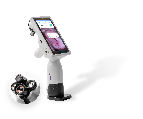READ FULL PAPER ON MOBILE COLPOSCOPY >
Abstract: Cervical cancer is the leading cause of cancer death for women in low resource settings, often affecting the most economically disenfranchised segment of the population. The key challenge with cervical cancer is the lack of an effective screening program for many of the at-risk, difficult-to-reach women. Outreach programs that utilize mobile clinics to increase access to screening and care in Baja California have been developed. However, many barriers such as quality assurance, efficient referral remained a challenge in this region. Visualization-based co-tests together with cytology (Pap smears) as a primary screen have been proposed. Here, mobile colposcopy with the enhanced visual assessment (EVA) System is used to capture an image immediately following a Pap smear. EVA images were reviewed by expert colposcopists. Initial or preliminary data from pilot services showed that Pap false positives and Pap false negatives maybe reduced by expert review of EVA images. This suggests that reviewing of EVA images may be instrumental in catching inaccurate Pap results, thereby improving care. Thus, there is a need to further explore the benefits of using EVA as additional information when conducting Pap smear screenings.
Keywords: Low-resource settings, mobile colposcopy, translational research, imaging







